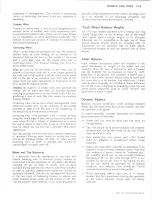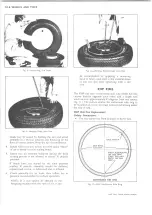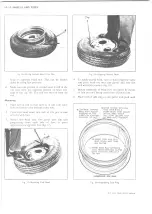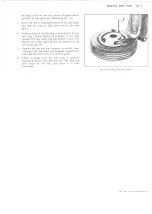
1 0 -2 WHEELS AND TIRES
1. Slow down during rainstorms or when roads are
slushy.
2. Slow down if road has standing water or puddles.
3. Replace tires when tread depth becomes 1/16".
4. Keep tires properly inflated.
Puncture Inspection and Repair
At each lubrication, tires should be checked for foreign
objects in the tread or breaks in the tread or sidewall. If
tire is punctured or otherwise damaged, it should be
repaired using one of several repair kits available
through tire manufacturers outlets.
Tread Wear
When the depth of tread becomes 1/16-inch or less,
there is a significant decrease in traction and anti-skid
properties, also, the majority of tire troubles will occur in
the last 10% of tire life.
The original equipment passenger type tires on Series 10
TREAD
TREAD
STILL GOOD
WORN OUT
Fig. 3 — P a s s e n g e r T y p e T ir e T r e a d W e a r
trucks incorporate built in tread indicators to assist in
judging when tires are worn out and should be replaced.
These indicators are molded into the bottom of the tread
groove and will appear as bands across the thread as a
visual reminder that the tire should be replaced (see fig.
3
).
MAINTENANCE
WHEEL NUT TORQUES
On a new vehicle or after the wheel has been changed,
the wheel nut torque must be checked at 100, 1,000 and
6,000 miles and every 6,000 miles thereafter.
TIRE ROTATION
The rotation of truck tires will minimize tire trouble and
produce longer tire life. With rotation, accelerated and
irregular tire wear on any one particular tire will be
spread out over the entire set, and replacement
frequency will be reduced. Tire wear may also contribute
to such trouble as poor handling and shimmy.
No definite tire rotation formula is applicable to all
trucks because of the wide range of usage. However,
certain fundamentals, mixed with experience and
observation, will assist the trucker in reducing tire costs.
A rotation sequence that moves the front tires to the rear
is a general recommendation. Due to different loading
conditions on the wheels, new tires which are broken in
on the front wheels usually produce the greatest overall
tire life.
The outer tire on a dual wheel will skid or drag on a turn
because of the difference in the turning radii of the inner
and outer tires. This results in faster wear of the outer
tire. In general, the tire with the largest diameter or least
wear should be at the outside of each dual wheel. In
addition, certain truckers have found when trucks are
operated continuously on high crown roads an increase
in air pressure of from 5 to 10 pounds in the outside tire
of each dual produces maximum tire life.
To equalize wear it is recommended that the tires be
rotated every 6,000 miles. Upon rotation, tire pressure
must be adjusted (front and rear) in accordance with the
recommendations for inflation pressure.
Inflation Pressure
Standard inflation pressures for tires are listed in the
"Load Capacity Chart" in Section 0 of this manual.
These are the minimum required tire pressures and tire
sizes for maximum permissible loads. Minimum tire
pressures for tires other than those listed in the "Load
Capacity Chart" can be determined from the "Tire Load
and Inflation Pressure Chart" on the following page,
using the weights shown on the vehicle GVW plate.
The use of improper tire inflation pressures can affect
tire life and load carrying capacity, and may affect
vehicle handling. Inflation pressures should be checked
at least once a month (and preferably more often) to
insure that the right amount of air is contained in the
tires. With regard to tire life, too little air pressure allows
abnormal deflection of the tire causing excessive
operating temperatures, while too much air pressure
prevents normal deflection, making the cord body more
vulnerable to road impacts.
Use of optional inflations is allowable only with a
reduced load as shown in the "Tire Load and Inflation
Pressure Chart." When operating at loads greater than
the optional reduced load, the inflation pressure must be
increased to the standard inflation for full rated loads.
On K10 4 wheel drive Pick-Ups and Utility vehicles with
passenger type tires, reduced tire pressures are
recommended for front tires only. Optimum ride and
handling require full maximum inflation pressure in the
rear tires at all times.
LIGHT DUTY TRUCK SERVICE MANUAL
Summary of Contents for Light Duty Truck 1973
Page 1: ......
Page 4: ......
Page 6: ......
Page 53: ...HEATER AND AIR CONDITIONING 1A 27 LIGHT DUTY TRUCK SERVICE MANUAL...
Page 115: ...LIGHT DUTY TRUCK SERVICE M A N U A L HEATER AND AIR CONDITIONING 1A 89...
Page 123: ...BODY 1B 3 Fig 6 Typical 06 Van LIGHT DUTY TRUCK SERVICE MANUAL...
Page 149: ...BODY 1B 29 Fig 84 Body Mounting 06 Fig 85 Body Mounting 14 LIGHT DUTY TRUCK SERVICE MANUAL...
Page 171: ...LIGHT DUTY TRUCK SERVICE M A N U A L Fig 2 Frame Horizontal Checking Typical FRAME 2 3...
Page 173: ...LIGHT DUTY TRUCK SERVICE M A N U A L Fig 4 10 30 Series Truck Frame FRAME 2 5...
Page 174: ...2 6 FRAME LIGHT DUTY TRUCK SERVICE MANUAL Fig 5 Underbody Reference Points G Van...
Page 185: ...FRONT SUSPENSION 3 11 Fig 16 Toe out on Turns LIGHT DUTY TRUCK SERVICE MANUAL...
Page 224: ......
Page 266: ......
Page 351: ...ENGINE 6 15 Fig ID Sectional View of Eight Cylinder Engine LIGHT DUTY TRUCK SERVICE MANUAL...
Page 375: ...EN G IN E 6 39 LIGHT DUTY TRUCK SERVICE MANUAL...
Page 376: ...6 4 0 ENGINE LIGHT DUTY TRUCK SERVICE MANUAL...
Page 377: ...ENG IN E 6 41 LIGHT DUTY TRUCK SERVICE MANUAL...
Page 378: ...LIGHT DUTY TRUCK SERVICE MANUAL Fig 37L K Series Engine Front Mount 6 42 ENG INE...
Page 400: ...6 6 4 ENG INE LIGHT DUTY TRUCK SERVICE MANUAL...
Page 401: ...ENG IN E 6 65 LIGHT DUTY TRUCK SERVICE MANUAL...
Page 402: ...6 6 6 ENGINE LIGHT DUTY TRUCK SERVICE MANUAL...
Page 403: ...E NG IN E 6 67 Fig 36V C Series Engine Mounts LIGHT DUTY TRUCK SERVICE MANUAL...
Page 410: ......
Page 423: ...EN G IN E C OOLING 6K 13 Fig 16 Overheating Chart LIGHT DUTY TRUCK SERVICE MANUAL...
Page 424: ...6 K 1 4 ENG INE COOLING Fig 17 Coolant Loss Chart LIGHT DUTY TRUCK SERVICE MANUAL...
Page 456: ...6M 32 ENGINE FUEL Fig K15 Accelerator Controls G Van L 6 LIGHT DUTY TRUCK SERVICE MANUAL...
Page 492: ......
Page 512: ...Fig 18e Vacuum Advance Diagram V8 Engine...
Page 516: ...6 T 2 4 E M IS S IO N CONTROL SYSTEMS LIGHT DUTY TRUCK SERVICE MANUAL...
Page 528: ......
Page 590: ......
Page 593: ...CLUTCHES MANUAL TRANSMISSIONS 7M 3 LIGHT DUTY TRUCK SERVICE MANUAL...
Page 598: ...7M 8 CLUTCHES MANUAL TRANSMISSIONS LIGHT DUTY TRUCK SERVICE MANUAL...
Page 642: ......
Page 654: ......
Page 743: ...FUEL TANKS AND EXHAUST 8 13 LIGHT DUTY TRUCK SERVICE MANUAL...
Page 744: ...8 14 FUEL TANKS AND EXHAUST LIGHT DUTY TRUCK SERVICE MANUAL...
Page 760: ...8 30 FUEL TANKS AND EXHAUST Fig 40 Exhaust Pipe P Models LIGHT DUTY TRUCK SERVICE MANUAL...
Page 761: ...FUEL TANKS AND EXHAUST 8 31 LIGHT DUTY TRUCK SERVICE MANUAL...
Page 763: ...FUEL TANKS AND EXHAUST 8 33 LIGHT DUTY TRUCK SERVICE MANUAL...
Page 766: ......
Page 832: ...LIGHT DUTY TRUCK SERVICE MANUAL Fig 106 Power Steering Pump Mounting Typical 9 66 STEERING...
Page 833: ...PUMP ASSEMBLY STEERING GEAR TYPICAL SMALL V8 TYPICAL LARGE V8 STEERING 9 67...
Page 861: ...STEERING 9 95 Fig 134 Power Steering Pump Leakage LIGHT DUTY TRUCK SERVICE MANUAL...
Page 864: ......
Page 876: ......
Page 886: ...11 10 CHASSIS SHEET METAL LIGHT DUTY TRUCK SERVICE MANUAL...
Page 891: ...ELECTRICAL BODY AND CHASSIS 12 5 LIGHT DUTY TRUCK SERVICE MANUAL...
Page 934: ......
Page 942: ......
Page 970: ......
Page 972: ......
Page 974: ......
Page 976: ...V...
Page 978: ......
Page 979: ......









































